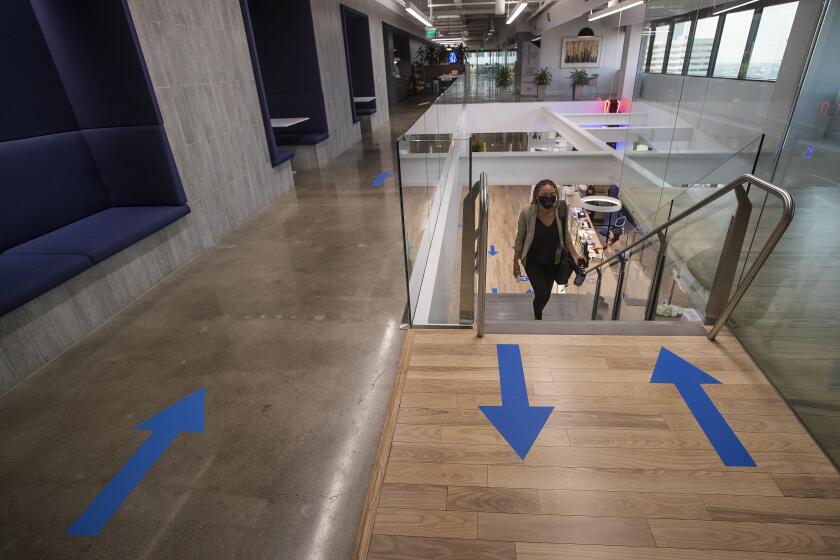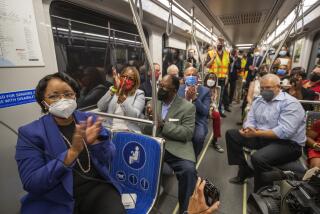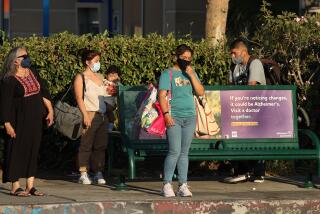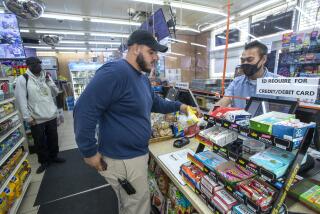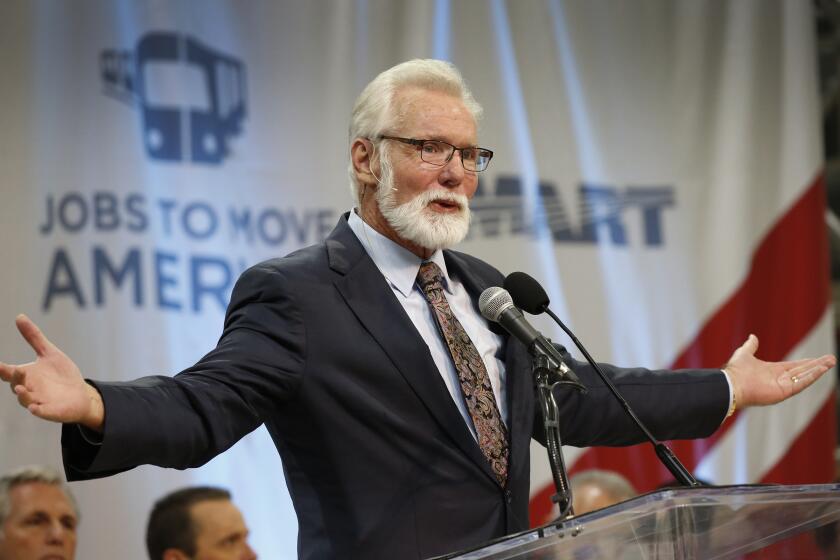Back to work with no masks or social distancing? California might allow it
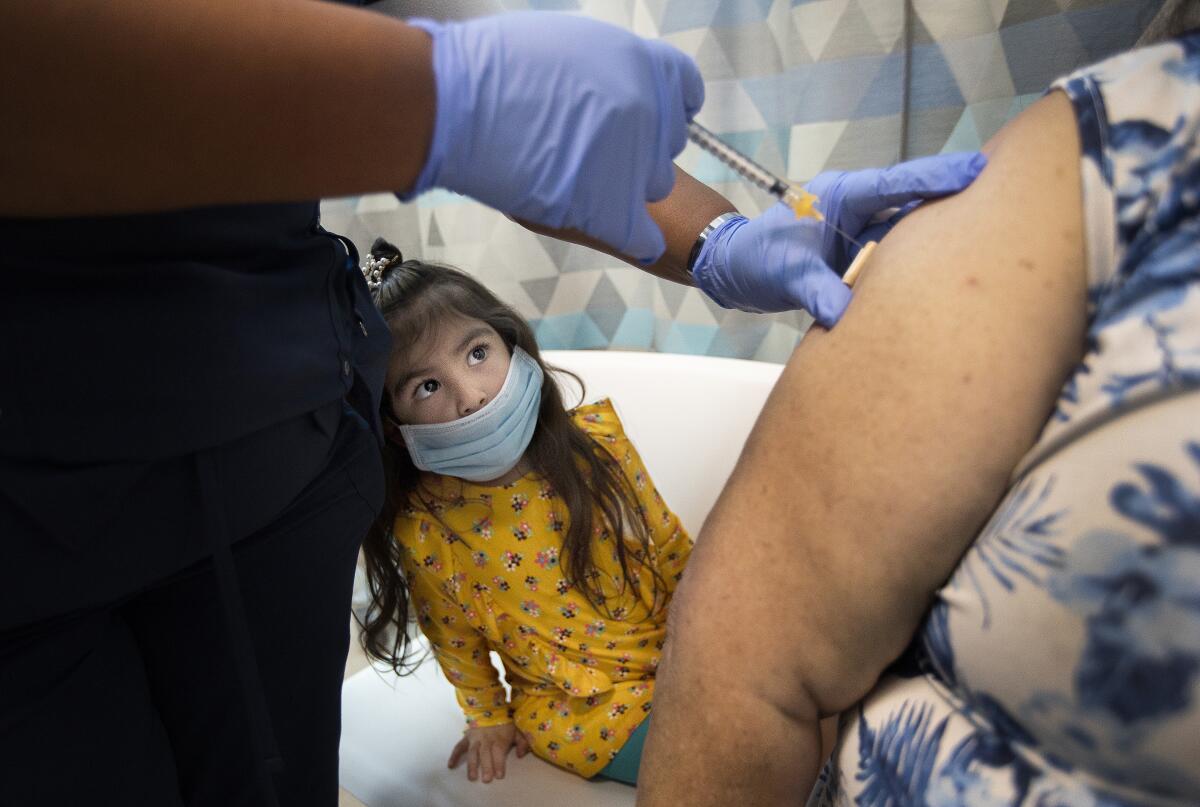
- Share via
SAN FRANCISCO — With coronavirus cases plummeting and vaccinations hitting new milestones, California is considering a dramatic liberalization of COVID-19 safety rules that would allow workers to return without masks and social distancing as long as everyone is vaccinated.
The push comes as employers are developing plans to bring back office workers after more than a year of remote work. There has been much debate about what the future of the office will look like, with some firms building elaborate barriers and spacing out work stations to avoid coronavirus spread.
But the dramatic success of efforts to contain COVID-19 is changing the dynamics, with public health officials believing workers don’t need some of those protections in workspaces where everyone has gotten their shots. That could cover offices and some manufacturing businesses.
But the relaxation of existing masking and physical distancing rules would not apply to workers who are exposed to customers who might not be vaccinated.
California is set to fully reopen its economy on June 15. On Wednesday, it celebrated another positive milestone: 67.3% of adult Californians are at least partially vaccinated for COVID-19. After a slow start, California now ranks 11th out of all states and is well above the national figure of 60.2%, federal data show. By comparison, the states with the highest levels of partial coverage for adults are Vermont, 78.6%; Hawaii, 77.1%; and Massachusetts, 75.9%.
Public health experts say the increasing cumulative rate of immunization, coupled with the small rate of coronavirus spread, is allowing officials to reduce restrictions.
“For the first time in a long time, I feel optimistic,” Dr. Sara Cody, the Santa Clara County health officer and public health director, and a key architect of the nation’s first regional stay-at-home order, told reporters. “For a while, it seemed uncertain to me whether the vaccines or the variants would win. And I think that team vaccine is in the lead, holding the lead and will win.”
California’s Occupational Safety and Health Standards Board is expected to weigh further steps to relax masking and physical distancing requirements for vaccinated workers.
Among proposed changes the board will weigh Thursday morning: dropping a requirement for workers to wear masks when everyone in a room is fully vaccinated and does not have COVID-19 symptoms; and no longer requiring physical distancing at locations where all employees are fully vaccinated.
Should the changes go into effect, a supermarket could potentially decide — if all workers on a shift were fully vaccinated — to let employees in a stockroom work without a mask or physical distancing. But vaccinated workers would still have to wear masks when working in public areas of the supermarket, where possibly unvaccinated customers might be shopping.
Should the board approve the proposal, it will be submitted to California’s Office of Administrative Law, which will have 10 days to review it and make a decision.
As COVID-19 recedes, California workers are being called back to the office. The office? Who remembers that place? And what will the return look like?
Current California emergency workplace health and safety regulations, which went into effect Nov. 30, require that workers wear masks when indoors, except when a worker is alone in a room or is eating or drinking, but they must be at least six feet away from other workers and outside air supply must be maximized. Workers must also wear a mask outdoors when less than six feet away from someone else.
Current rules also generally require workers be separated from one another by at least six feet.
If not everyone in a room is vaccinated, the proposed standards call for employees to still wear face coverings and stay six feet away from other workers.
If a workplace did seek to eliminate masks and physical distancing among employees who are fully vaccinated, the employer would need to obtain the workers’ vaccination records under the state’s proposal.
Santa Clara County has gone a step further and on Wednesday issued a health order requiring employers to determine which employees are fully vaccinated. Employees can decline to answer, but employers would then have to treat that worker as unvaccinated as workplaces navigate loosened masking and physical distancing requirements for vaccinated workers.
It was not immediately clear how workplace safety standards might change after June 15, when California is expected to allow vaccinated members of the public to stop wearing masks in indoor public settings.
The state’s proposal retains the previous instruction that employers develop policies to “minimize employee exposure to COVID-19 hazards originating from any person not wearing a face covering, including a member of the public.”
The proposal does suggest dropping, by the end of July, the state’s physical distancing requirement for all workers and the requirement to install cleanable solid partitions, such as in front of cash registers, where employees cannot maintain physical distance at all times.
The state’s proposed rules also ban companies from ordering employees to take off their masks should they choose to keep them on.
The state’s proposal would generally apply to all places of employment except for medical facilities, such as hospitals and nursing facilities, which have more stringent requirements.
Some infectious diseases experts suggested the proposed relaxation in California’s workplaces could be loosened further.
They pointed out that fully vaccinated people are highly protected from the coronavirus, even when in close contact with unvaccinated people. In the rare instance that a vaccinated person gets infected anyway, chances are they will either show no symptoms or have very mild symptoms, and they are unlikely to transmit the virus to other people.
“I feel that they are trying to be conservative,” said Dr. Robert Kim-Farley, a medical epidemiologist and infectious diseases expert at the UCLA Fielding School of Public Health. “I think it’s very likely that the board, as we go out further and have more and more people vaccinated and go to extremely low levels of disease circulating in the population, I would anticipate that they would revisit these recommendations.”
Importantly, the chances people today in California are likely to get infected are far lower than they were at the height of the pandemic. California already has one of the lowest daily coronavirus case rates in the nation. And so, Dr. Monica Gandhi, infectious diseases expert at UC San Francisco, said as a vaccinated person, while she wouldn’t be unmasked in a densely packed crowd in a place with a high case rate, she would feel fine doing so in San Francisco, which has a very low prevalence of the virus.
Notably, scientists in the U.K. — buoyed by the nation’s high rate of vaccination — decided to embark on an unusual experiment in Liverpool, where they allowed thousands of people who tested negative for the virus to attend a crowded music festival with no masks or physical distancing.
More than two weeks later, “they saw no uptick in cases in Liverpool,” Gandhi said.
That’s why, Gandhi said, officials should be thinking about how to change rules for when there are vaccinated and unvaccinated workers in the same room. Gandhi said one idea is to drop mask mandates once a certain percentage of residents has received at least one dose of vaccine — like 70% — and the daily per capita number of coronavirus cases has fallen to, say, between 2 and 3 cases per 100,000 residents.
Dr. Robert Wachter, chair of the Department of Medicine at UC San Francisco, said in a tweet he’d only go maskless indoors under three conditions: if he’s sure everyone is vaccinated; if unvaccinated people there are masked; or if the local coronavirus case rate is so low that even an unvaccinated, unmasked person is unlikely to have COVID-19.
While it’s true the vaccines are highly effective, Wachter said he still doesn’t want to get COVID-19 if he can help it, not wanting to be the rare fully vaccinated person who might become very sick. He said that scientists can’t say for certain yet whether a case of mild COVID-19 in a vaccinated person can lead to “long COVID,” which can leave patients sick for months.
“I’m happy to be indoors [with] un-masked vaccinated people,” Wachter tweeted. Otherwise, “I’d recommend you keep the mask on for another month or so while more folks get vaccinated. We’ll get there, but let’s not rush it too much.”
More to Read
Sign up for Essential California
The most important California stories and recommendations in your inbox every morning.
You may occasionally receive promotional content from the Los Angeles Times.
